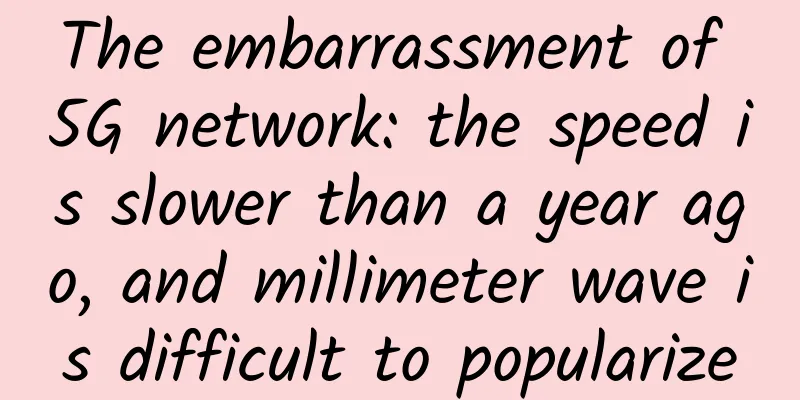The embarrassment of 5G network: the speed is slower than a year ago, and millimeter wave is difficult to popularize

|
On May 7, 5G networks, as a new generation of mobile communication technology, should be faster and better than 4G networks, but this is not the case. According to speed test data from network diagnostic company Ookla, the upload and download speeds of 5G networks in countries around the world have generally declined compared to a year ago. Even the most advanced 5G networks can only reach a speed of 1 Gbps, which is far below the ideal download speed of 20 Gbps set by the International Telecommunication Union. According to IEEE, there are many reasons for this. First, as more and more users buy new mobile phones and other devices, the number of people using 5G networks has increased, leading to network congestion. This is a problem that every generation of mobile communication technology will encounter. Mark Giles, an industry analyst at Ookla, said: "If you look back at the 4G era, it was the same. So when 4G was first deployed, there was a lot of capacity available for those early users. Then as more and more users came in, the capacity was used up, and the density of base stations needed to be increased." Secondly, most operators have adopted non-standalone 5G networks when deploying 5G networks. This approach is to build 5G networks on the core infrastructure of existing 4G networks. Although the performance of non-standalone 5G networks is not as good as that of standalone 5G networks, its cost and difficulty are much lower because it does not need to be built from scratch. This strategy also limits the development of 5G networks because operators can only build 5G networks in places where there are existing base stations and other facilities. But cost is not the only factor, there are also some regulatory and licensing issues that plague operators. Especially in dense urban areas, sometimes the biggest challenge is to find a suitable place to place a new base station. In addition to cities, there are different problems in suburban or rural areas. One of the biggest selling points of 5G networks is the ability to take advantage of new frequency bands, especially millimeter wave bands (24 GHz to 40 GHz), which can support lower latency and higher data rates. But high frequency bands also have a disadvantage, which is that they have a short propagation distance. This is good for cities, but not very practical for suburban or rural areas. As more and more places start using 5G networks, there will be some performance degradation overall. IT Home noted that millimeter waves have not been widely used either, and are barely visible outside of a few countries, including the United States. Even in the United States, companies that were initially optimistic about millimeter waves, such as Verizon, have turned to other newly opened frequency bands, such as the C-band (4 GHz to 8 GHz). Giles said: "As of 2022, there are 140 operators in the world with millimeter wave licenses in 24 countries. But only 28 operators have actually deployed millimeter waves in 16 countries. So this is a very small group. Only a small number of operators are really pursuing millimeter waves." The 20 Gbps 5G download speeds originally proposed by the International Telecommunication Union remain just an ideal. Millimeter wave has some applications only in places where a large number of users need to use the network at the same time, such as stadiums and airports. But the failure to build out millimeter wave as a key component of 5G networks, whether due to high costs or technical limitations, has not helped 5G networks get through its growth stage. Of course, not all countries have 5G networks that are performing poorly. Ookla's speed test data shows that four countries are bucking the trend: Canada, Italy, Qatar, and the United States. For the United States, Giles believes that more available new spectrum bands have helped the country's operators stay ahead of the curve on new networks. And for Qatar, heavy investments for the 2022 World Cup include building a strong 5G network. It’s unclear whether the early setbacks of 5G networks will affect the development of 6G networks, but there are some possible effects. For example, given the disappointing performance of millimeter waves, the industry may reduce investment in terahertz wave research and instead consider how to merge cellular and Wi-Fi technologies in areas that need dense coverage. |
<<: How long will it take for 5G small base stations to "take off"?
>>: Enabling Zero Trust Networking for Microservices with Istio Service Mesh
Recommend
By the end of 2016, my country had achieved 100% implementation of the real-name system for telephone users.
[51CTO.com original article] In recent years, spa...
HostKvm Double 11 60%-80% off, top up $50 get $10, top up $100 get $25
HostKvm also released a promotional plan for Doub...
MWC2023: Huawei releases a series of innovative solutions for simplified networks and data centers to accelerate the transition to an intelligent world
[Barcelona, Spain, February 28, 2023 ] During t...
5G, IoT and AI: Art and tech jobs for 2021
We are witnessing a massive transformation in the...
Increase power, adjust location, and switch channels to speed up WiFi.
Have you adapted to your daily work and life afte...
The Internet of Things has become a popular entry point for domestic operators’ eSIM technology
Apple phones have promoted the development of SIM...
China Telecom faces four major challenges in network reconstruction of SDN/NFV practice
On July 11, 2016, China Telecom released the &quo...
Real-time advertising recommendation system implemented by SpringBoot and Apache Doris
This topic aims to provide readers with an in-dep...
How do Huawei, ZTE and the three major operators plan for 5G?
What is 5G? 5G is the fifth generation of mobile ...
ExtraVM first month 30% off starting at $1.5, AMD Ryzen9 series, 1~10Gbps unlimited traffic, data centers in the United States/Netherlands/Japan/Singapore, etc.
ExtraVM recently released a 70% discount on the f...
2018 Yunnan-Huawei Software Industry Summit was held on December 20
The 2018 Yunnan-Huawei Software Industry Summit w...
5G Development Trend Survey
Overview The COVID-19 incident in 2020 did not we...
Kubernetes uses OkHttp client for network load balancing
During an internal Java service audit, we discove...
Interview surprise: Why does TCP need a three-way handshake?
The TCP three-way handshake is a classic intervie...
RackNerd: Cheap VPS starting at $10 per year, multiple data centers in San Jose/Los Angeles/Seattle/New York/Dallas, etc.
This weekend, we will share the cheap VPS package...









